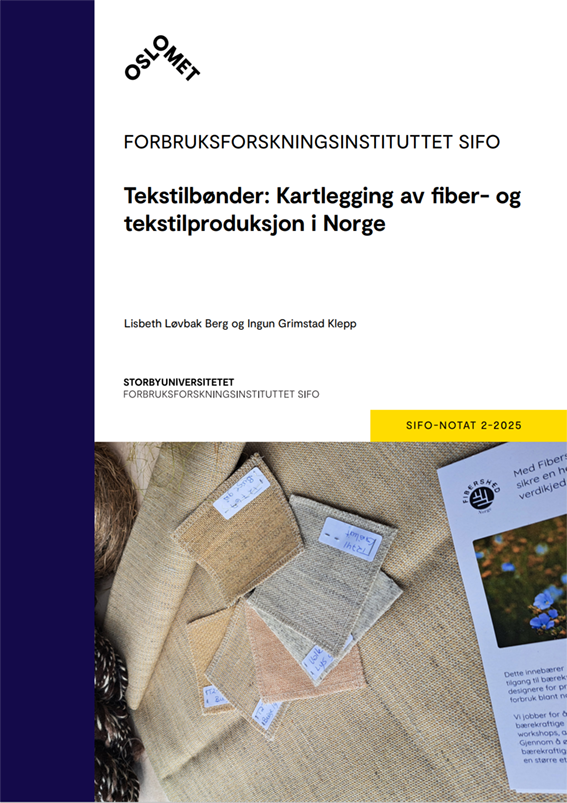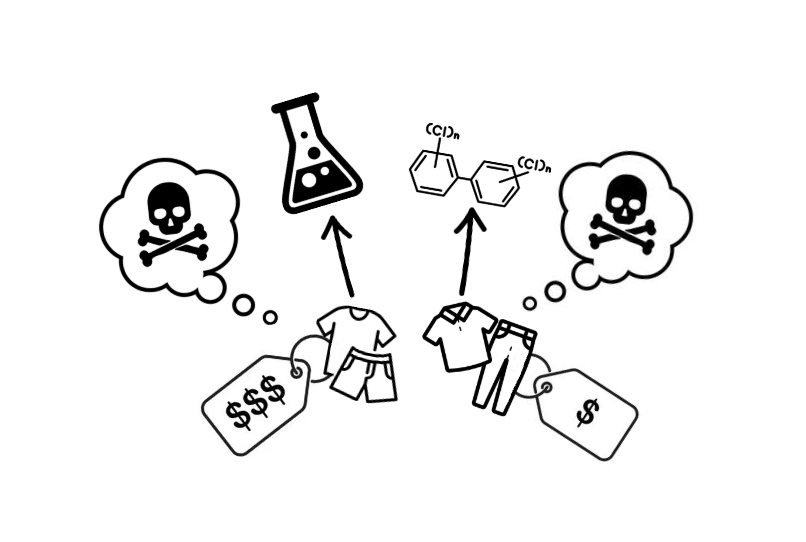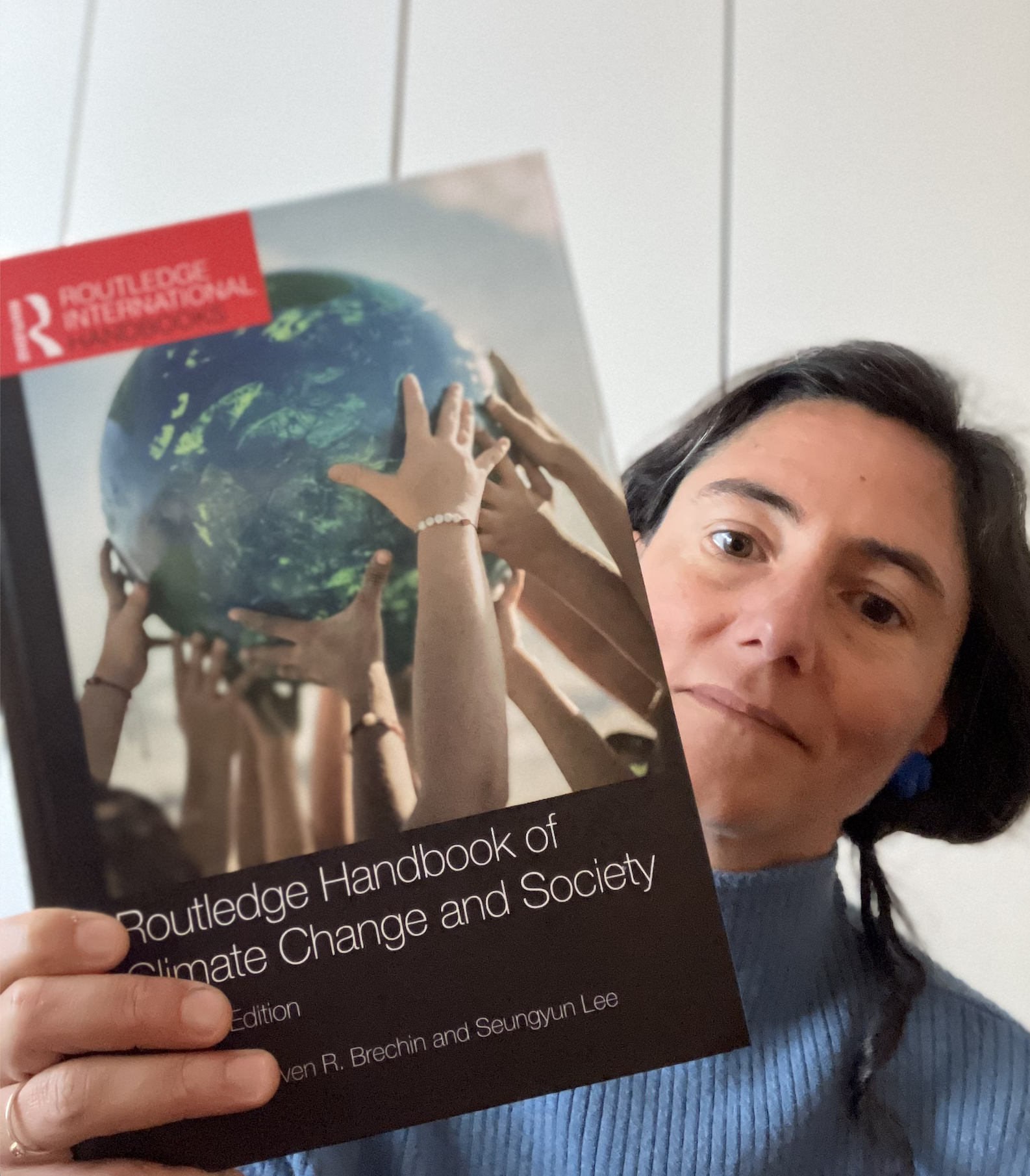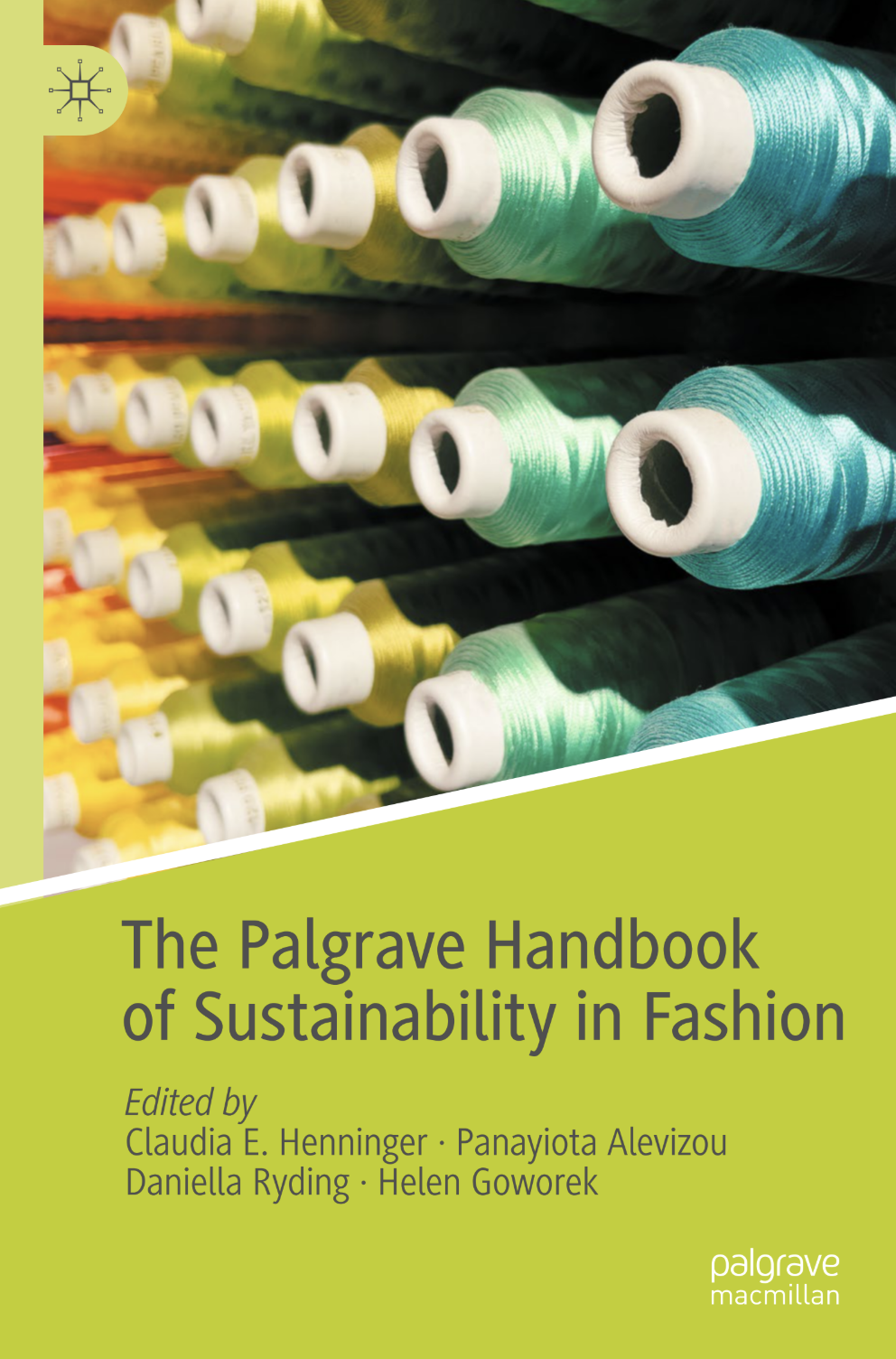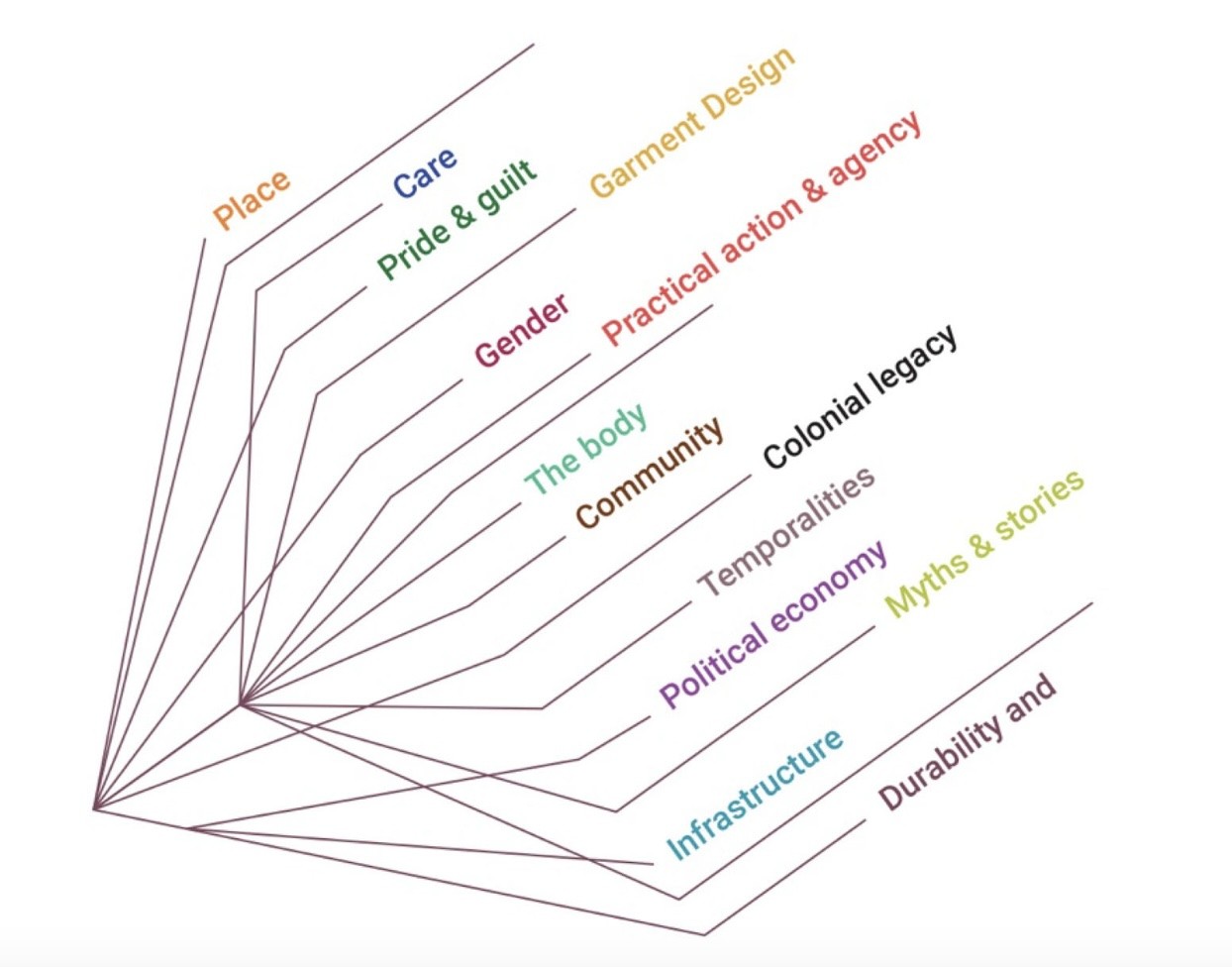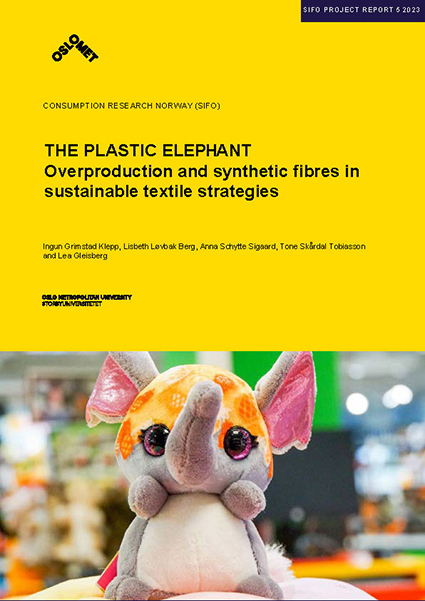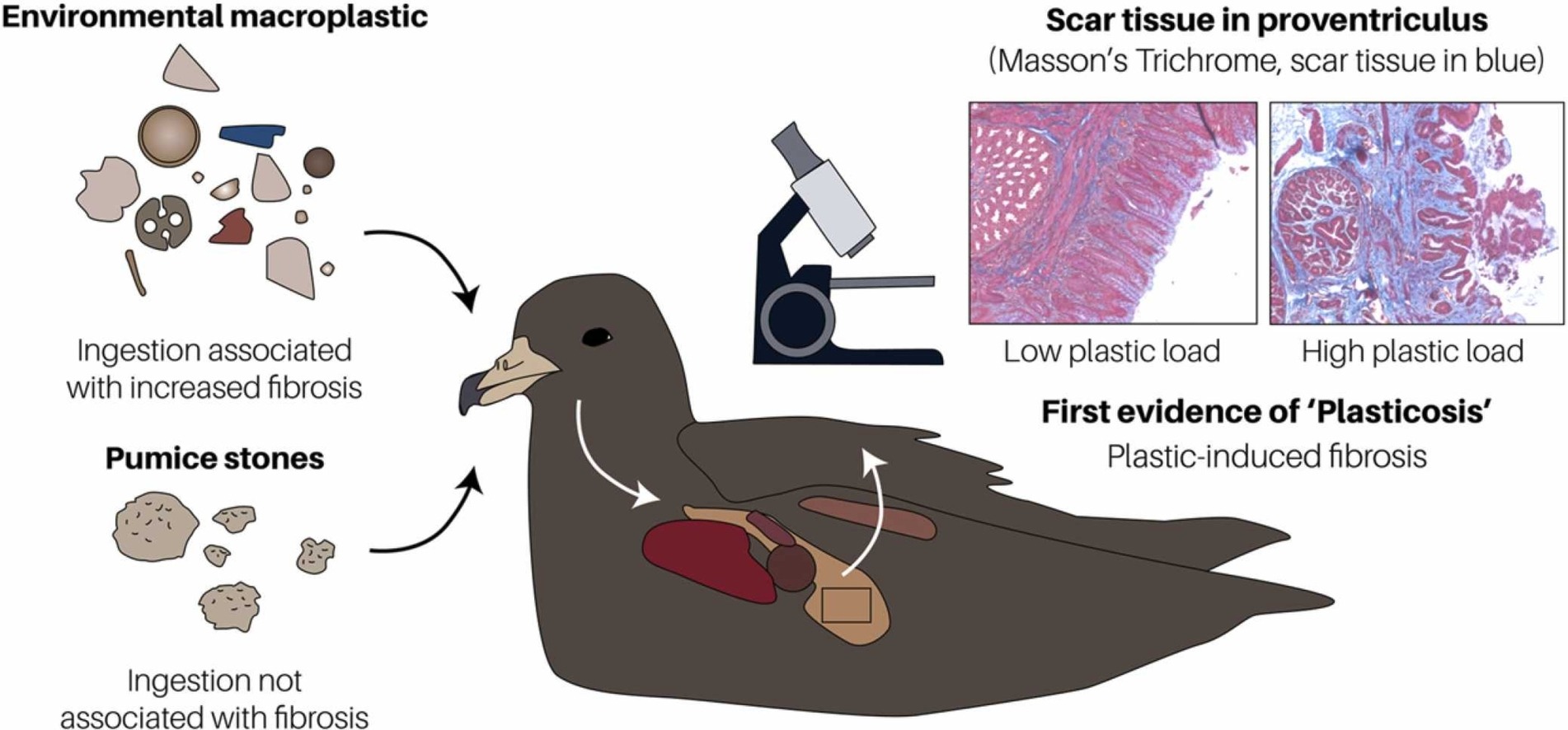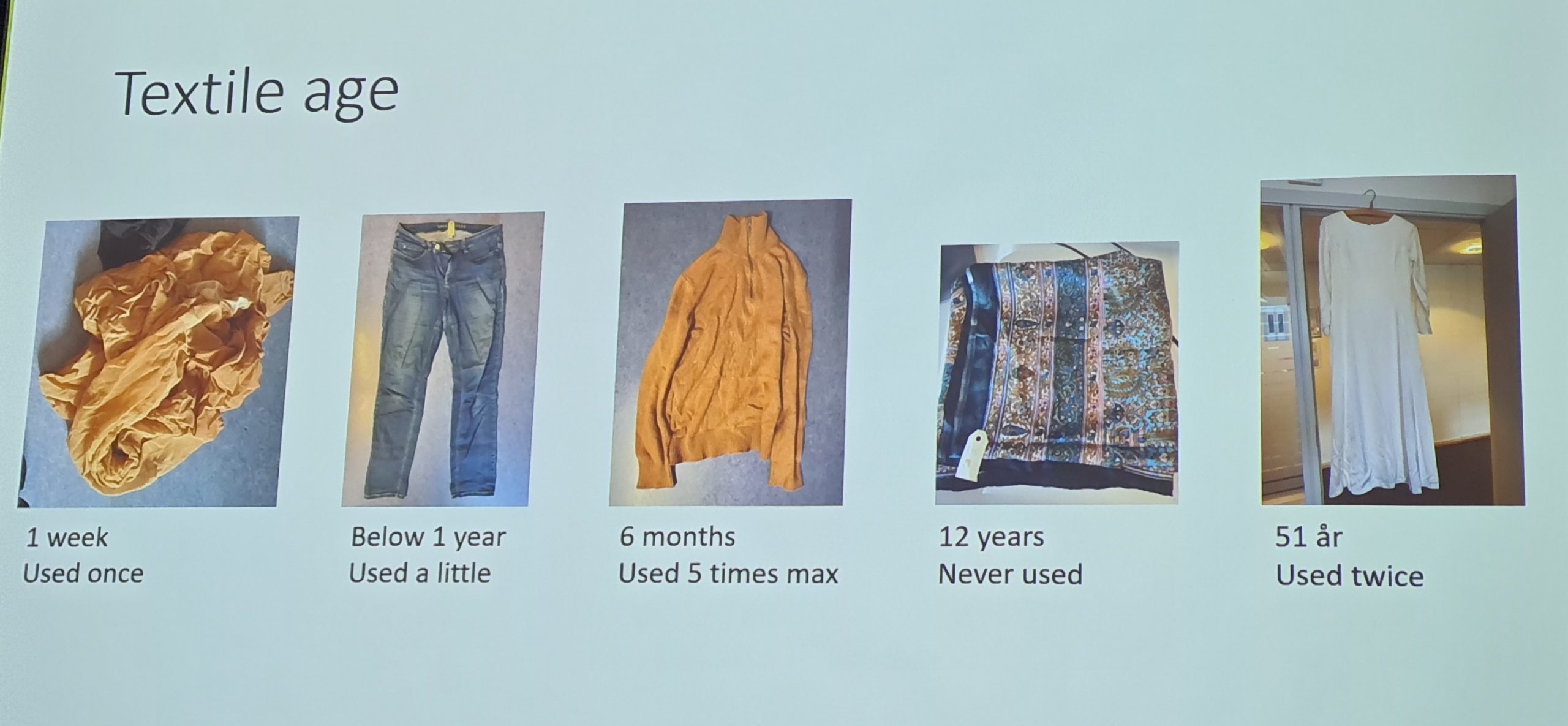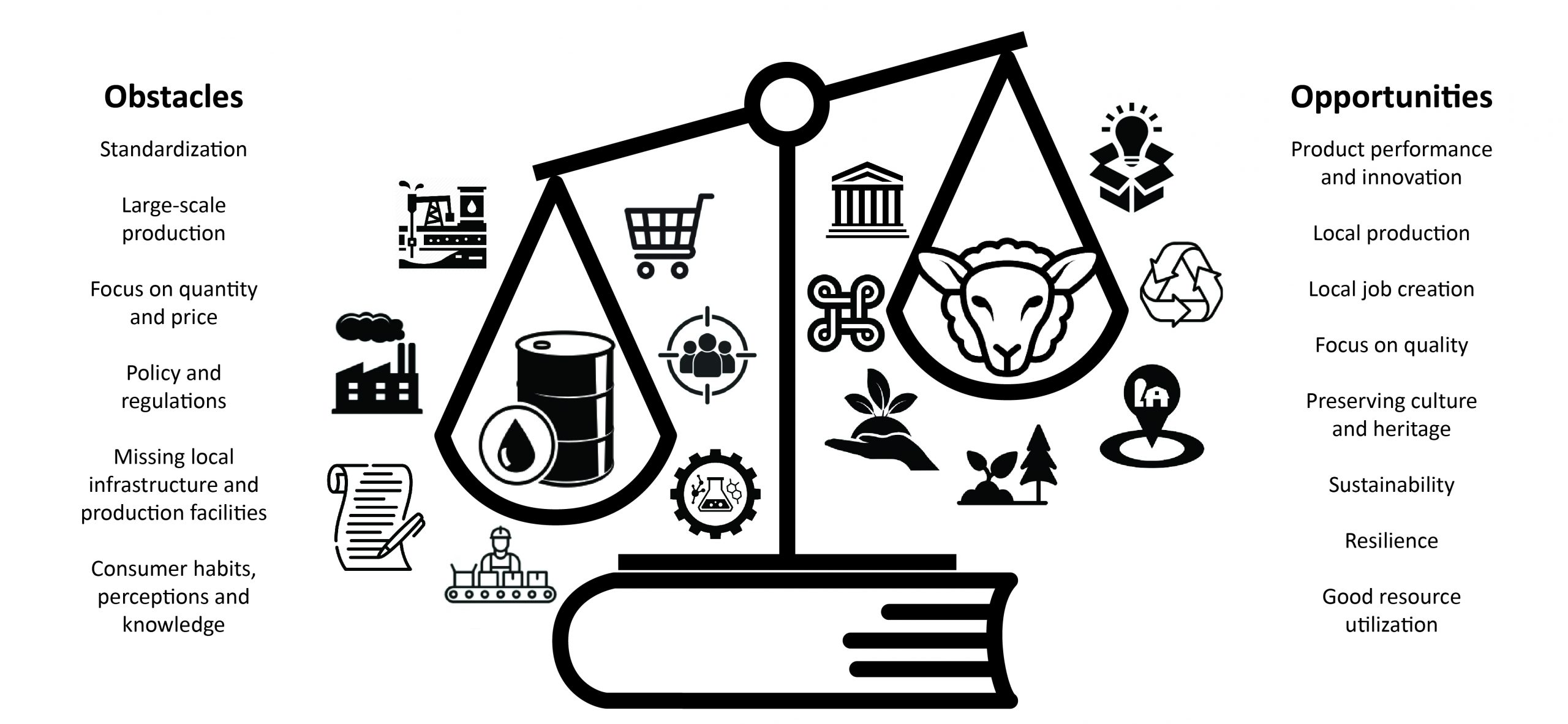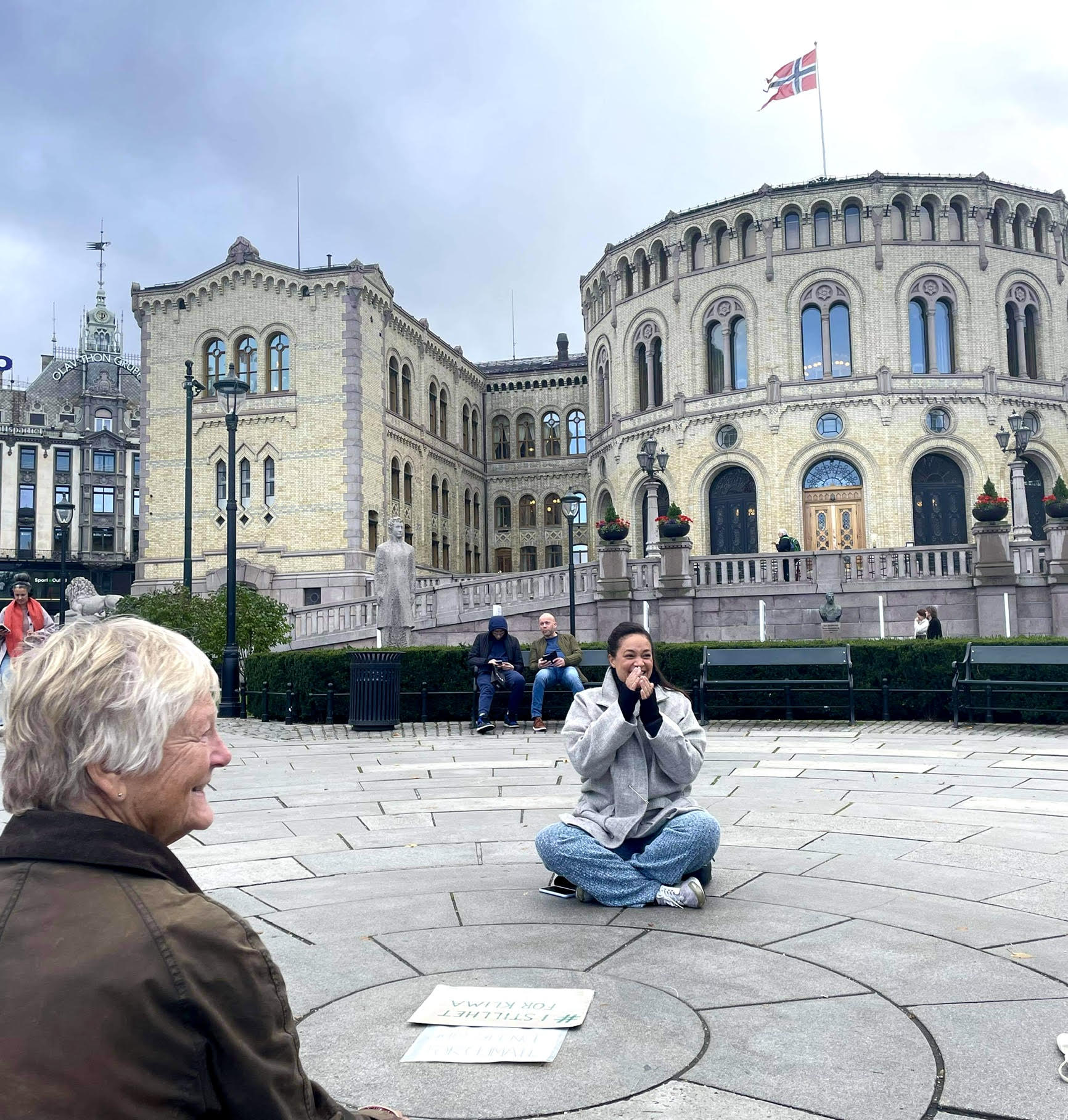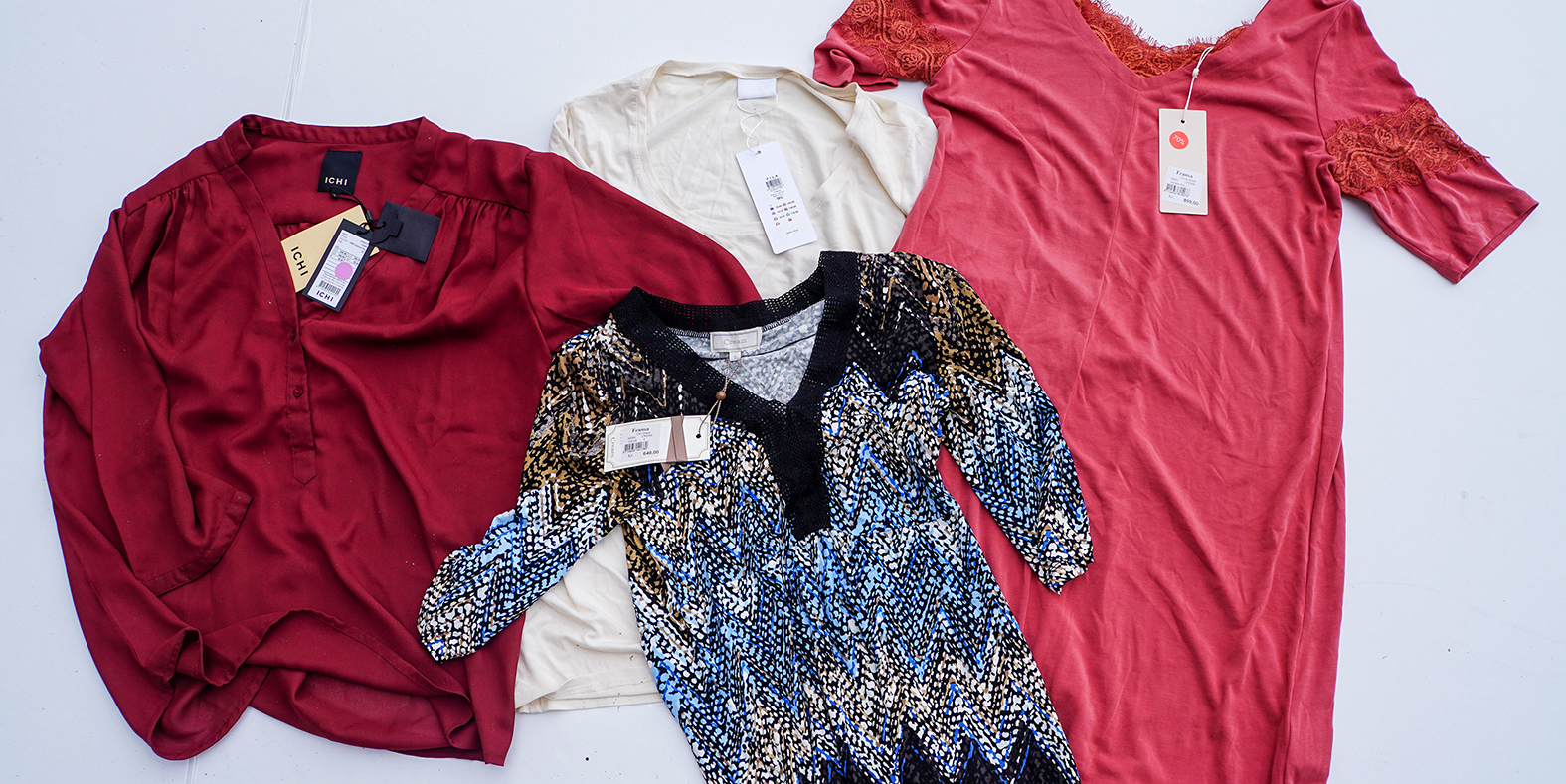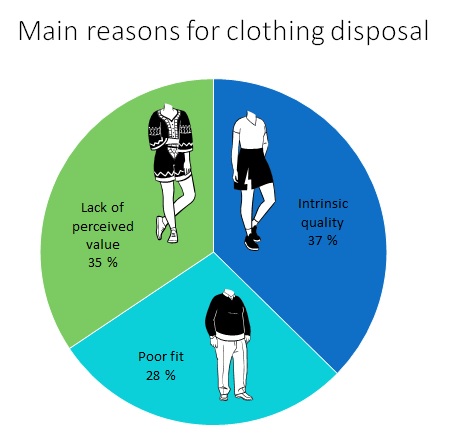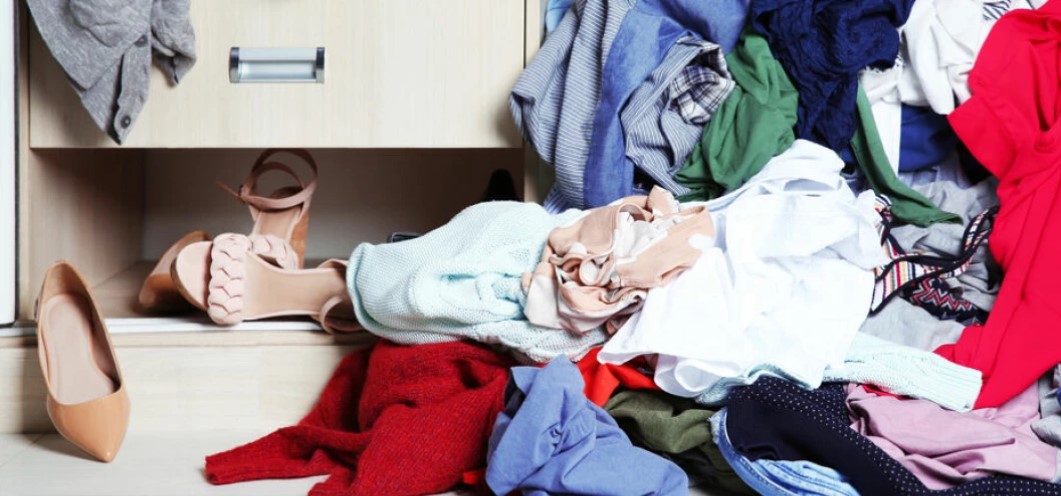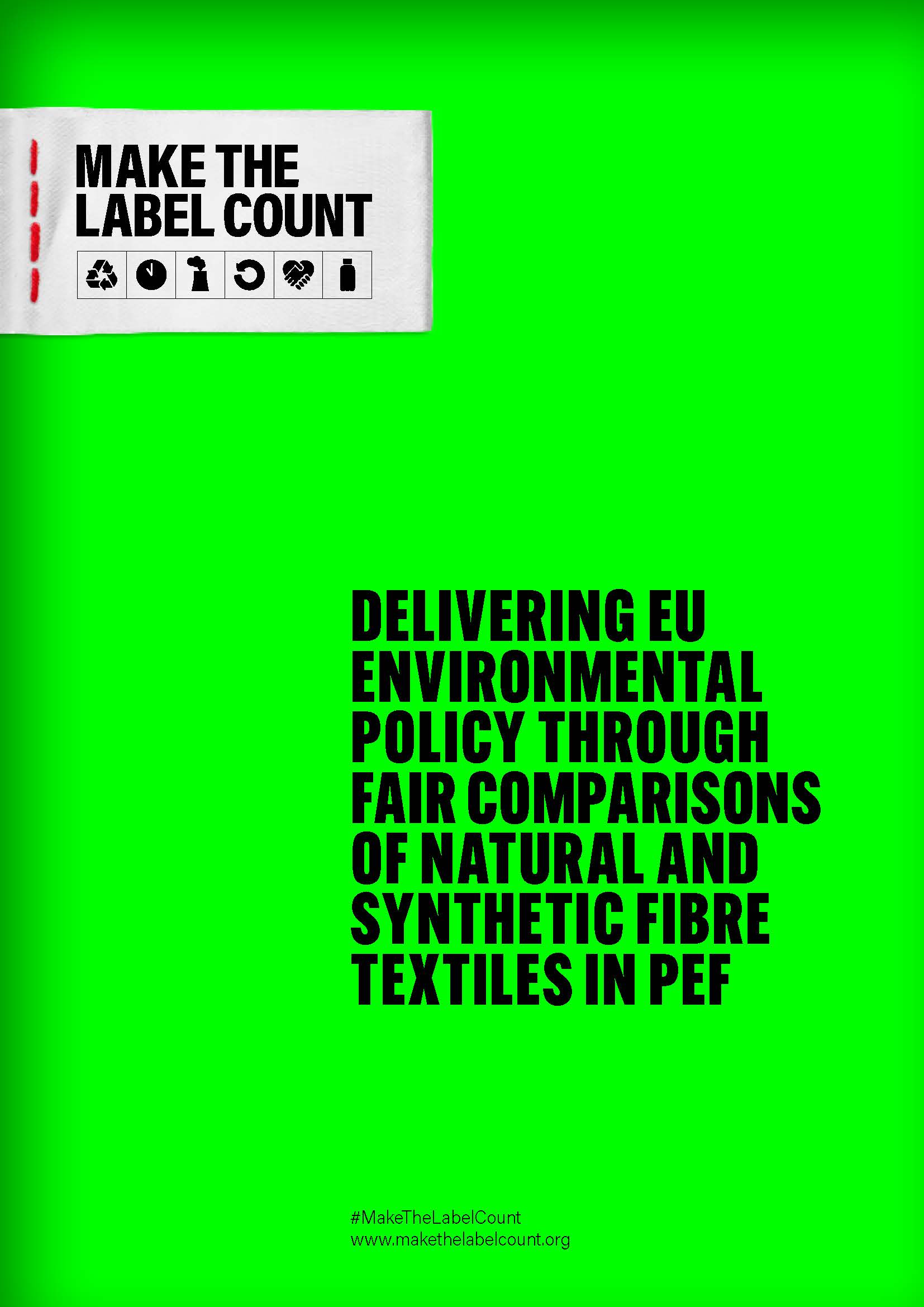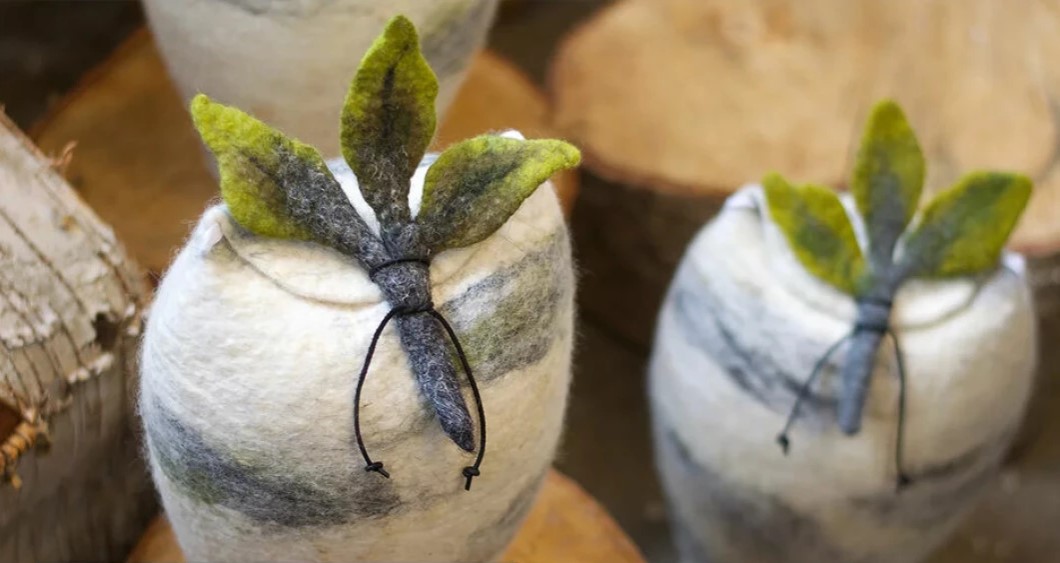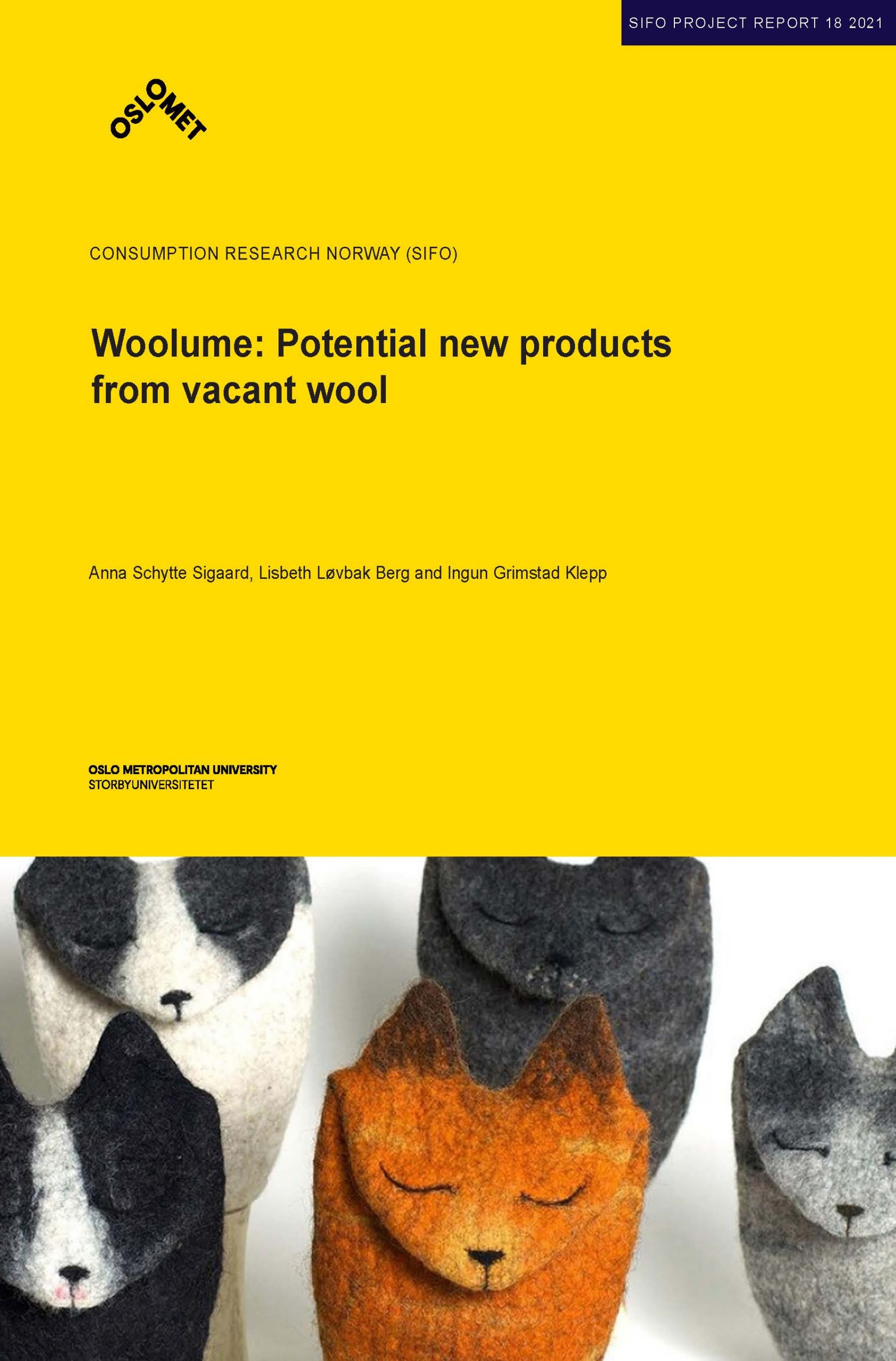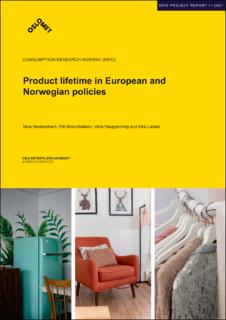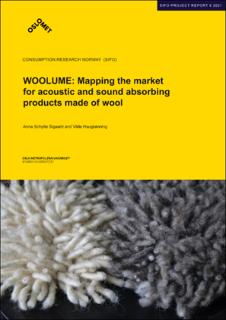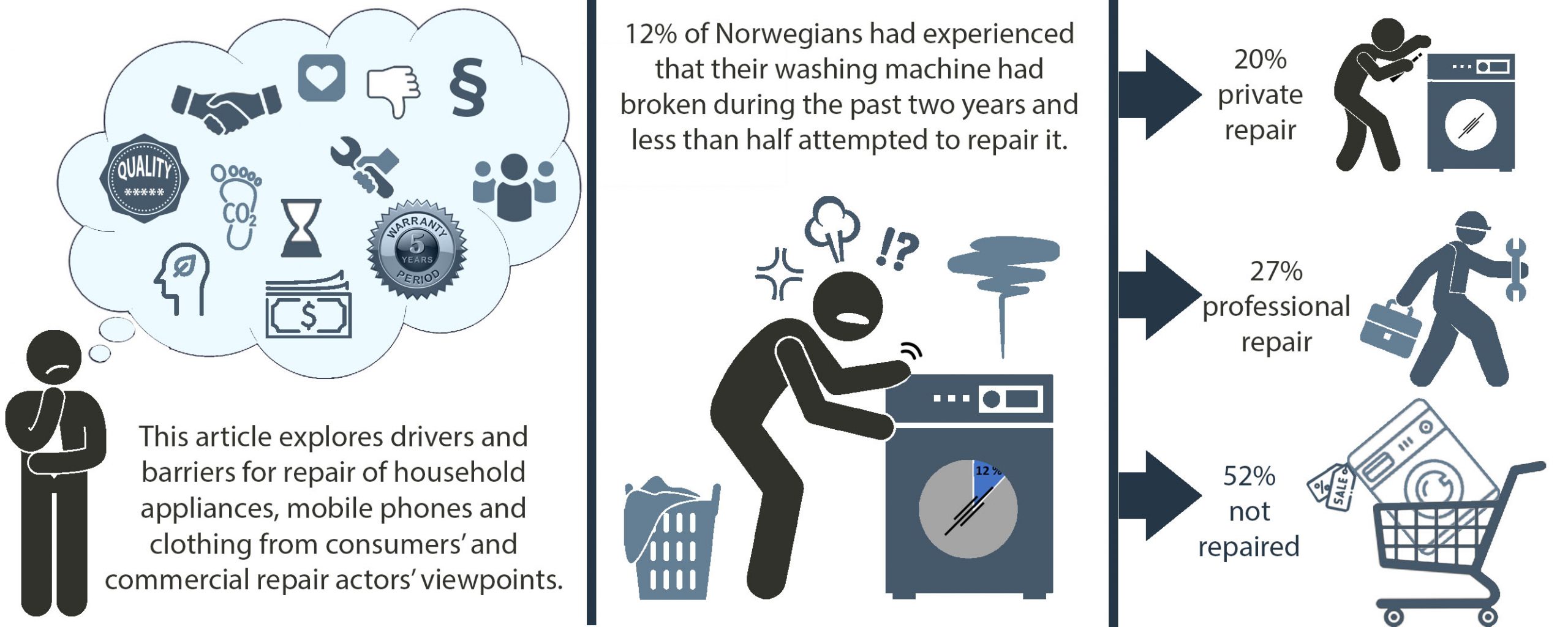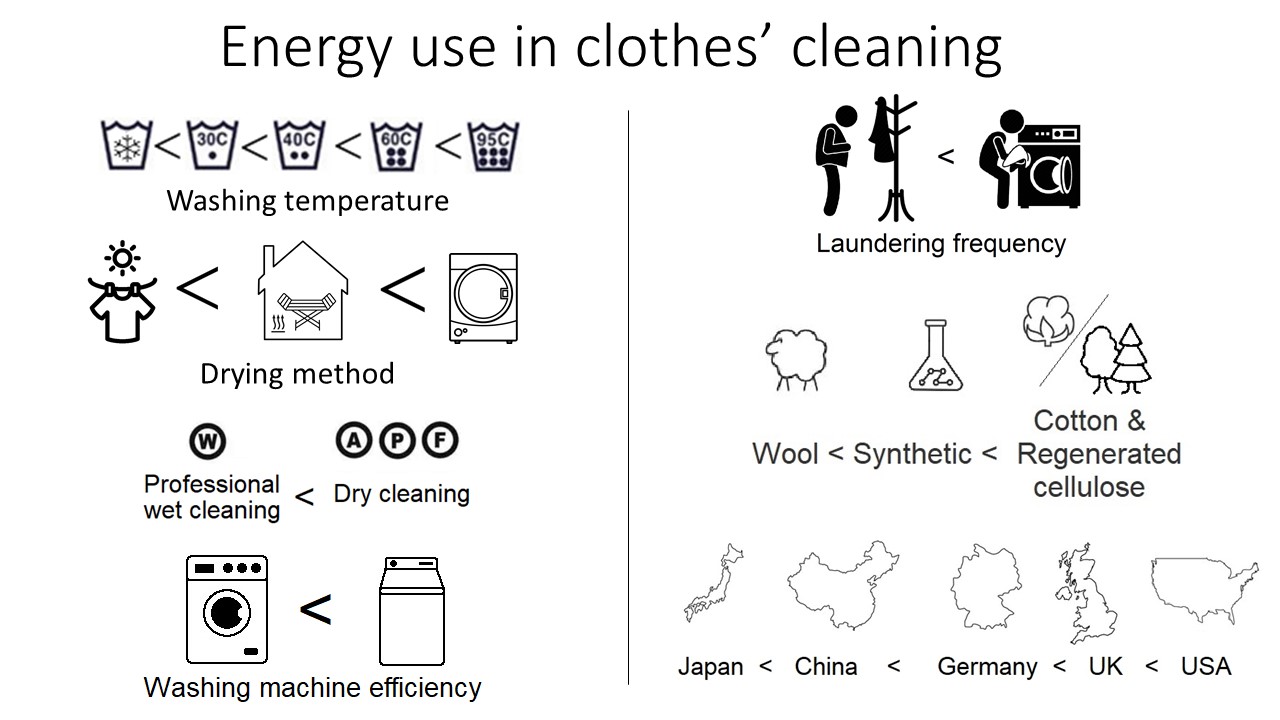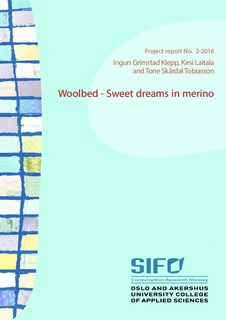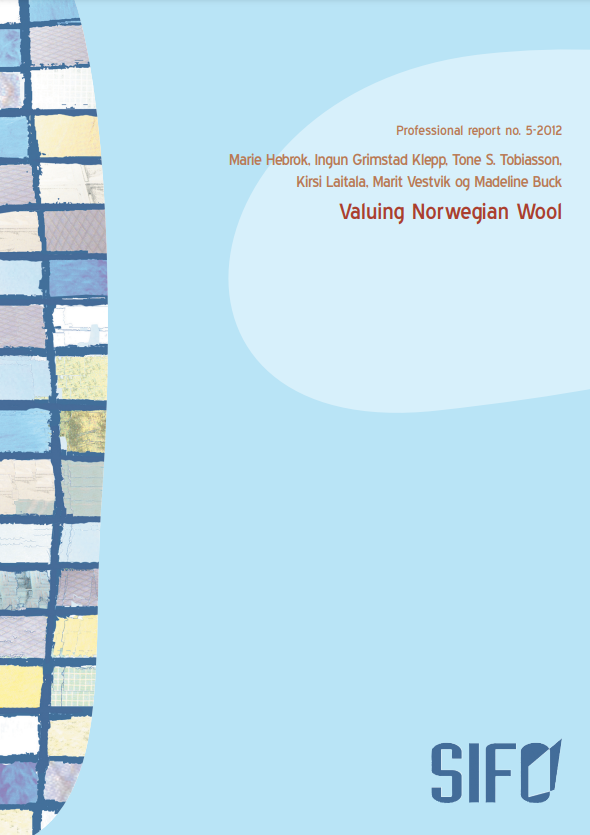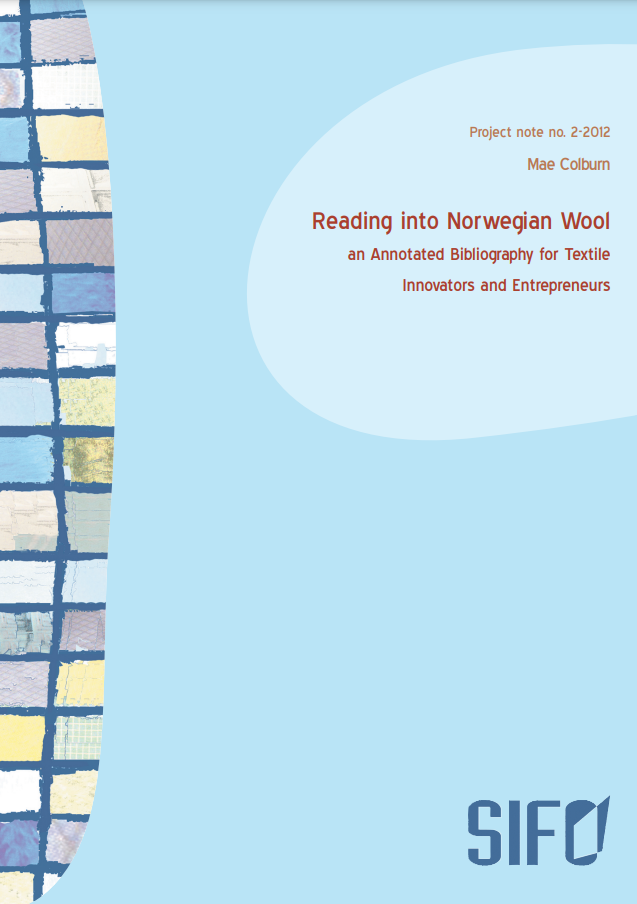Publications
Below you can find all our research publications sorted by date. Click on the buttons below to find the theme that you are interested in.
New report summarizing knowledge on the environmental challenges associated with textile waste.
Textile waste as an environmental challenge – A Knowledge Base for What Now? The Change Lab (Hva nå? Endringslaben) – Nasjonalt vitenarkiv The report, written by Kirsi Laitala, discusses the significant environmental challenges posed by textile waste and provides a knowledge base for the Norwegian learning platform What Now? The Change Lab, aimed at educating…
‘Creating’ variety without waste: Pre-industrial dress practices as inspiration for updating the sustainability discourse
Authors: Ingun Grimstad Klepp, Bjørn Sverre Hol Haugen, Marie Ulväng, Pernilla Rasmussen, Ingrid Haugsrud This study explores how ideas of variety were created and practised among women and men of different social strata in Norway and Sweden before the big changes in the second half of the nineteenth century. Three researchers with in-depth knowledge of…
Understanding garment durability through local lenses: a participatory study with communities across the globe
Authors: Hester Vanacker, Andrée-Anne Lemieux, Kirsi Laitala, Michelle Dindi, Sophie Bonnier & Samir Lamouri. Abstract The overproduction of garments, often of low quality, contributes significantly to environmental degradation, especially in the Global South. Therefore, assessing the durability of garments has attracted the attention of industry organizations and legislators. Recent research has identified both intrinsic and extrinsic dimensions of durability and their…
Textile Farmers: Mapping of Fibre and Textile Production in Norway
Summary In this note, we present the results of a survey conducted in the project Textile Farmers and Fashion Agriculture: New momentum for local utilisation of all agricultural resources, led by Fibershed Norway. Based on responses from 124 small and 8 larger entities, we see that the grassroots in the Norwegian textile value chain are…
Continue Reading Textile Farmers: Mapping of Fibre and Textile Production in Norway
From Clothes to Skin: Chemical Safety in Ultra-Fast Fashion and Luxury Brands’ Clothes
This literature review explores the presence and associated health risks of hazardous chemicals in clothing, with a particular focus on dermal exposure. It investigates the potential health effects of skin contact with toxic substances in garments and whether clothing sold from fast fashion brands and luxury brands contain different levels of chemicals. It emerged that…
Weigthing Weight: Exploring Clothing Fiber Composition and Its Impact on Garments’ Weight
Author: Rita Dominici Introduction Various textile management policies are under debate, with particular attention to the effectiveness of weight-based eco-modulation, a policy strategy aimed at minimizing the environmental impact of products (Lifset et al., 2023). To better understand this mechanism, it is important to first know that fashion is widely regarded as “one of the least…
The environmental impact of product lifetime extension: a literature review and research agenda
Authors: Irene Maldini, Ingun Grimstad Klepp & Kirsi Laitala Abstract Consumer goods environmental policy is increasingly focusing on product durability and product lifetime extension (PLE) to reduce their impact. Given the growing societal relevance of PLE, this review investigates the discourse about its environmental effects, and the empirical knowledge that substantiates this discourse. One hundred and nine relevant articles were…
The EU Textile Strategy: How to Avoid Overproduction and Overconsumption Measures in Environmental Policy
Authors: Irene Maldini and Ingun Grimstad Klepp Abstract The environmental impact of clothing has become critical in recent decades and the growing volume of products in circulation plays a main role. The European Union’s Strategy for Sustainable and Circular Textiles is a particularly influential policy in this area given the number of regulatory instruments included and…
Gender, Fashion, Sustainability
Author: Kate Fletcher Abstract The ability to affect sustainability outcomes is often culturally gendered. This article examines sustainability practices in fashion in the light of core themes in the gender and sustainability literature, drawing upon a re-analysis of a decade-old dataset of resourceful clothing use practices from the Local Wisdom project. In the dataset, evidence…
Comparing Male and Female Wardrobes: Gender Dynamics in the Practice of Dressing
Authors: Vilde Haugrønning, Ingrid Haugsrud Abstract This chapter explores the influence of gender on clothing consumption and the impact on differences in clothing volumes between men and women. Based on a qualitative and quantitative wardrobe study, we employ Schatzki’s (2002) social ontology of practice combined with Butler’s (1990) gender performance concept to examine the relationship between gender and clothing…
Continue Reading Comparing Male and Female Wardrobes: Gender Dynamics in the Practice of Dressing
Pakket i plast
“Wrapped in plastic” was a talk given during the Forskning i Friluftsliv conference by Kate Fletcher and Ingun Grimstad Klepp.
Overcoming barriers for “strong” sustainable consumption policy: the case of the Amsterdam Doughnut
Abstract This case study of the Amsterdam Doughnut highlights how barriers for “strong” sustainable consumption policy pinpointed in the literature were to some extent overcome in the city policy of Amsterdam, the Netherlands, in the period of 2018–23. The study builds on interviews conducted in 2020 and 2023 with key stakeholders participating in the policymaking…
Clothing Care – The Palgrave Handbook of Sustainability in Fashion
Authors: Ingrid Haugsrud, Ingun Grimstad Klepp and Kirsi Laitala Abstract The impact of the fashion industry on the environment is undoubtedly size-able. In response, the last decade has seen various changes in the fashion industry landscape, from new digital technologies that enhance zero waste productions, the emergence of the digital platform economy, to the development…
Continue Reading Clothing Care – The Palgrave Handbook of Sustainability in Fashion
Decentering Durability: Decarbonizing and Decolonizing Ideas and Practices of Long-Lasting Clothes
Authors: Kate Fletcher and Anna Fitzpatrick Abstract Durability is widely recognized as a key feature of materially resource-ful, lower-carbon clothing lives. Yet most of what is known about long-lasting garments is rooted in Euro-American ways of thinking, andreproduces its structures, priorities, values and resulting actions. Thispaper brings a decolonial concern to understandings of clothing durabil-ity…
Urban transitions toward sufficiency-oriented circular post-consumer textile economies
Authors: Katia Vladimirova, Yassie Samie, Irene Maldini, Samira Iran, Kirsi Laitala, Claudia E. Henninger, Sarah Ibrahim Alosaimi, Kelly Drennan, Hannah Lam, Ana-Luisa Teixeira, Iva Jestratijevic & Sabine Weber Abstract Wealthy cities are the primary hubs for excessive consumption and disposal of fashion and textiles. As such, cities have the power to support urban transitions toward…
Imagining Future(s): Mining Literacies of Sustainable Consumption
Abstract This study is about mining the past to better understand how we imagine and shape the future. The present report is a deliverable from Work Package 1: “Mine” in the research project IMAGINE: Contested Futures of Sustainability. WP1 aimed to construct a conceptual framework based on Paul Ricoeur’s study of the concept of imagination…
Continue Reading Imagining Future(s): Mining Literacies of Sustainable Consumption
Holding on or letting go: Conflicting narratives of product longevity
Authors: Lisbeth Løvbak Berg, Marie Hebrok Abstract Increasing product longevity is seen as an effective way to reduce consumption within the circular economy. This paper explores narratives of product longevity, focusing on textiles, household appliances, and furniture as expressed by Norwegian business representatives and consumers. The study reveals dominant narratives of physical and emotional durability…
Continue Reading Holding on or letting go: Conflicting narratives of product longevity
The way forward for WOOLUME
This note looks at knowledge transference between a country of high wool utilisation (Norway) and a country of low wool utilisation (Poland). The findings that are presented here, are collected through semi-structured interviews, via Zoom, in person and also with one written response. All interviewees were project partners. Economics and scale are important themes, especially…
The Impact of Modes of Acquisition on Clothing Lifetimes
Authors: Kirsi Laitela, Ingun Grimstad Klepp and Lisbeth Løvbak Berg Abstract Reducing the environmental impact of clothing is dependent on a reduction of the produced volume. This chapter discusses how mode and volumes of acquisition impact the lifetimes of clothing. Based on our scoping review and reanalysis of international wardrobe audit data, we find that…
Continue Reading The Impact of Modes of Acquisition on Clothing Lifetimes
Washing Clothes
Clothes must not only suit the user and the occasion but also be clean for us to be well dressed. The meaning of cleanliness and the methods to achieve this goal has changed throughout history, but it has been central in our clothing practices. In this chapter, we will show how the understanding of dirty…
The devaluation of stockings
Authors: Tone Rasch, Ingrid Haugsrud, Kirsi Laitala and Atle Wehn Hegnes Abstract Consumer practices related to how we use and take care of products have changed throughout history. Especially within clothing consumption, the changes have accelerated in the Twentieth Century. In this paper, we use thin nylon stockings for women as an example product to…
Studying clothing consumption volumes through wardrobe studies: a methodological reflection
Authors: Irene Maldini, Vilde Haugrønning and Lucrecia de León Abstract This paper introduces the relevance of volume-centric research in studies of clothing use. The global production of garments has grown dramatically in recent decades, bringing along significant environmental challenges. However, knowledge is lacking about why people deal with clothing quantities in such varied ways, and…
Narratives of product longevity: a business vs. consumer perspective
Authors: Lisbeth Løvbak Berg and Marie Hebrok Abstract This paper explores narratives of product longevity expressed by businesses and consumers, with the aim of illuminating and comparing ways in which the two stakeholder groups express their engagement with products in the context of prolonging their lifespans. We base our analysis on consumer focus groups and…
Continue Reading Narratives of product longevity: a business vs. consumer perspective
Regulating Fast Fashion out of Fashion
Authors: Ingun Grimstad Klepp and Kerli Kant Hvass Abstract Among sustainable fashion and textile themes, product durability has recently come into focus within EU policy making. The dominant understanding is that increased textile lifespan will reduce environmental impacts, but this intrinsic link is not supported by research. The volume of clothing produced poses the greatest…
Why won’t you complain? Consumer rights and the unmet product lifespan requirements
Authors: Kirsi Laitala, Lisbeth Løvbak Berg and Pål Strandbakken. Abstract The Consumer Purchases Act is one of the cornerstones for ensuring that businesses are liable for defective or faulty products that do not meet the minimum requirements for lifespans. However, this right is too seldom used by consumers. This paper discusses the reasons for not…
Continue Reading Why won’t you complain? Consumer rights and the unmet product lifespan requirements
Flawed or redundant: products with long lifespans against the odds
Authors: Harald Throne-Holst and Kirsi Laitala Abstract Many strategies are proposed that should enable the consumers to keep using the products for longer, but there is less research on which and how consumer practices contribute to longer lifespans. In this paper we focus on two specific, distinct ways of reaching long lifespans: 1) retaining redundant…
Continue Reading Flawed or redundant: products with long lifespans against the odds
THE PLASTIC ELEPHANT: Overproduction and synthetic fibres in sustainable textile strategies
Authors: Ingun Grimstad Klepp, Lisbeth Løvbak Berg, Anna Schytte Sigaard, Tone Skårdal Tobiasson andLea Gleisberg Summary In this report, we examine national, international and corporate strategies for sustainable textiles to understand if and how they embrace the increased production volumes based on synthetic materials, which can be referred to as the ‘plastic elephant in the…
Microplastics or microfibers: Does anyone really get what this is about?
OPINION: What we do know, is that all synthetic clothing and materials, sooner or later, will become microplastics, a «time-delayed» pollution bomb. And thus, they will ultimately become a problem for seabirds, and us. A new report on microfibers in waterways is gaining attention, as it claims the results show more natural fibers than synthetic ones,…
Continue Reading Microplastics or microfibers: Does anyone really get what this is about?
Want Not, Waste Not: Preliminary findings
Author: Anna Schytte Sigaard Summary This project note presents preliminary findings from a PhD project looking into textile waste from Norwegian households. 28 households collected textiles that they would have otherwise discarded for a period of six months. The textiles were collected by the PhD candidate during visits to the households where qualitative interviews were…
Reducing Plastic in Consumer Goods: Opportunities for Coarser Wool
Lisbeth Løvbak Berg, Ingun Grimstad Klepp, Anna Schytte Sigaard, Jan Broda, Monika Rom and Katarzyna Kobiela-Mendrek. Abstract Production and use of plastic products have drastically increased during the past decades and their environmental impacts are increasingly spotlighted. At the same time, coarse wool, a by-product of meat and dairy production, goes largely unexploited in the…
Continue Reading Reducing Plastic in Consumer Goods: Opportunities for Coarser Wool
Natural and Sustainable? Consumers’ Textile Fiber Preferences
by Anna Schytte Sigaard and Kirsi Laitala Abstract Textile fibers have become a major issue in the debate on sustainable fashion and clothing consumption. While consumers are encouraged to choose more sustainable and circular textile materials, studies have indicated that a reduction in production and consumption has the greatest potential to reduce the total environmental impact. This can…
Continue Reading Natural and Sustainable? Consumers’ Textile Fiber Preferences
A functioning ‘functional unit’?
Ingun Grimstad Klepp and Tone Skårdal Tobiasson What on earth is the functional unit of a winter coat, t-shirt, a warm sweater… or a pair of boots? For LCA-based tools and category rules, there is a central idea of a “functional unit”. How this will function in the ongoing work with EU’s PEFCR (Product Environmental…
VikingGold: Weaving History and Fashion together
Fashion met cultural history in the project VikingGold, and the two were woven together into a beautiful wool fabric, that found its way to museum exhibits and Norwegian national tv as the most sustainable fabric of the future. During the annual event Oslo Runway, the Norwegian actress Iselin Shumba debuted as a catwalk model on a…
Continue Reading VikingGold: Weaving History and Fashion together
How to make sure Extended Producer Responsibility becomes a silver bullet
This is a letter sent to commissioners and members of the European Commission in October 2022, from 4 participants in the Wasted Textiles project that explains their suggestions for a way of developing an EPR scheme that addresses volumes. They suggest an Eco-modulation based on volumes in the waste and therefore include the growing online…
Continue Reading How to make sure Extended Producer Responsibility becomes a silver bullet
Review of clothing disposal reasons
Authors: Kirsi Laitala and Ingun Grimstad Klepp, SIFO Abstract Garment lifetimes and longer serviceable life play important roles in discussions about the sustainability of clothing consumption. A compilation of the research on clothing disposal motivations shows that there are three main reasons for disposal: Intrinsic quality (37%): Wear and tear-related issues such as shrinkage, tears…
Deep diving into wardrobes provides important knowledge on clothes and their environmental impact
Authors: Vilde Haugrønning, Ingun Grimstad Klepp and Anna Schytte Sigaard Norway leads the way in methods for studying the use of clothing. This is knowledge that is important in sustainability studies of apparel. How many clothes are there in our wardrobes? What is used a lot and what do you seldom wear, and why? Which…
Delivering EU Environmental Policy Through Fair Comparisons of Natural and Synthetic Fibre Textiles in PEF
Make the Label Count Campaign: Simon J. Clarke, Ingun G. Klepp, Kirsi Laitala and Stephen G. Wiedemann. Summary Sustainability has become a priority objective for the European Union (EU). It is a key driver for policy development through the global leadership role the EU has taken in addressing climate change, decoupling economic growth from resource…
Hit them where it hurts: Producers of fast fashion should pay the most
OPINION: How best to deal with the negative environmental impact of the clothing industry? The writers behind this opinion suggest a system in which those who sell large volumes of clothes that don’t last pay the most.
Continue Reading Hit them where it hurts: Producers of fast fashion should pay the most
Acoustic Performance of Sound Absorbing Materials Produced from Wool of Local Mountain Sheep
Katarzyna Kobiela-Mendrek, Marcin Bączek, Jan Broda, Monika Rom, Ingvild Espelien and Ingun Klepp Abstract Wool of mountain sheep, treated nowadays as a waste or troublesome byproduct of sheep husbandry, was used for the production of sound-absorbing materials. Felts of two different thicknesses were produced from loose fibres. Additionally, two types of yarn,ring-spun and core rug,…
Local clothing: What is that? How an environmental policy concept is understood
The textile industry is characterized by global mass production and has an immense impact on the environment. One garment can travel around the world through an extensive value chain before reaching its final consumption destination.
Continue Reading Local clothing: What is that? How an environmental policy concept is understood
Textile Cleaning and Odour Removal
Consumers’ textile care practices today are characterized by frequent laundering. The importance of the removal of odours has increased, especially the smell of sweat. This chapter summarizes knowledge about removing odour from textiles.
The Consumer Perception of Odour
Human olfaction sense is one of the highly underestimated senses since historical times. Fortunately, this has changed in recent times, as the perception of odour or scent by people has received increasing attention through several research works from different scientific disciplines.
What does the Minister of the Environment think about apparel and the environment?
This is not easy to ascertain from two answers sent to Conservative Member of Parliament Liv Kari Eskeland in response to her questions about the EU’s new Product Environmental Footprint (PEF) scheme, which is in danger of labeling natural fibers as the least environmentally friendly.
Continue Reading What does the Minister of the Environment think about apparel and the environment?
From burial urns to surfboards – wool can be used to make just about anything
Ingun Grimstad Klepp, Lisbeth Løvbak Berg and Anna Schytte Sigaard. OPINION: There’s no such thing as bad wool, only bad use. In the Norwegian folk song Kråkevisa (The Crow Song), a man-made everything from a boat, to windows, to barrels of meat and fat from a bird he shot. There is a lot to learn from this…
Continue Reading From burial urns to surfboards – wool can be used to make just about anything
Woolume: Potential new products from vacant wool
Anna Schytte Sigaard, Lisbeth Løvbak Berg and Ingun Grimstad Klepp Summary This report gives an overview of the market for alternative wool products with the perceived potential to be made using vacant wool. The work is based on a desktop study and interviews with manufacturers and distributors, focusing on products made of wool and their…
Continue Reading Woolume: Potential new products from vacant wool
The COP26 plastic uniforms are a disaster for the environment
Ingun Grimstad Klepp, Tone Skårdal Tobiasson, Ingrid Haugsrud The UN Climate Change Conference in Glasgow, COP26, is in full swing. The event aims to be carbon neutral. The guests will be served local food and are encouraged to walk, cycle or use public transport. The clothes should also be environmentally friendly. A thousand volunteers have…
Continue Reading The COP26 plastic uniforms are a disaster for the environment
Fossil Fashion: How Green Growth is Undermining the Circular Economy
Why the fashion industry, driven by the green growth notion, cannot recycle its way out of the climate crisis By Tone Skårdal Tobiasson Tone is co-editor of “Local, Slow and Sustainable Fashion Fibres: Wool as a Fabric For Change”, from Palgrave Macmillan, out on December 18, 2021. As the world comes to terms with the climate…
Continue Reading Fossil Fashion: How Green Growth is Undermining the Circular Economy
Product lifetime in European and Norwegian policies
The objective in this report is to better understand how the increased product lifetime option has been positioned in policies over the past twenty years. By means of policy document analysis, we explore product lifetime positioning in the EU’s circular economy policies, Norwegian political party programs and official documents, environmental NGO documents, consumer organisation policies…
Continue Reading Product lifetime in European and Norwegian policies
WOOLUME: Mapping the market for acoustic and sound absorbing products made of wool
This report is the first deliverable from work package 2 of the WOOLUME project. The main goal of WOOLUME is to explore different ways of using wool from Polish Mountain Sheep to achieve better utilisation of resources and value creation. The aim of the report has been to map the market for acoustic and sound…
Continue Reading WOOLUME: Mapping the market for acoustic and sound absorbing products made of wool
Durable or cheap? Parents’ acquisition of children’s clothing
Parents are faced with a plurality of choices and concerns when it comes to the acquisition of clothing for their children. This paper explores how parents employ longevity in consumption of children’s clothing from a practice-oriented perspective. The material consists of 6 focus groups with 40 parents who have at least one child under the…
Continue Reading Durable or cheap? Parents’ acquisition of children’s clothing
Consumer practices for extending the social lifetimes of sofas and clothing
Consumers play an essential role in efforts to extend product lifetimes (PL) and consumers’ practices can determine how long and active lives products get. Applying the framework of Social Practice Theory, this paper argues that in order to suggest changes to how consumers can contribute to longer product lifespans, research needs to focus on consumer…
Continue Reading Consumer practices for extending the social lifetimes of sofas and clothing
Reducing environmental impacts from garments through best practice garment use and care, using the example of a Merino wool sweater
Garment production and use generate substantial environmental impacts, and the care and use are key determinants of cradle-to-grave impacts. The present study investigated the potential to reduce environmental impacts by applying best practices for garment care combined with increased garment use. A wool sweater is used as an example because wool garments have particular attributes…
Increasing repair of household appliances, mobile phones and clothing: Experiences from consumers and the repair industry
Increasing product lifespans is one of the most effective environmental strategies and therefore repair is a part of the circular economy approach that aims to keep products and materials longer in use. This article explores drivers and barriers for repair from consumers’ and commercial repair actors view-points, in order to understand how the repair rates…
Global differences in consumer practices affect clothing lifespans
Most studies of clothing and related habits are carried out within a country. However, apparel production and sales are a highly globalized industry, with many of the same large chains operating worldwide. It is thus quite possible that the use of the same mass-produced clothing differs between various geographical areas. Based on a practice theoretical…
Continue Reading Global differences in consumer practices affect clothing lifespans
Ecolabelling of clothes has catastrophic consequences for the environment
The interest in looking at the environmental consequences of clothes is growing. This was inevitable for two reasons: The clothing industry has been pointed out at as one of the worst polluting industries in the world. And we need to focus on all sectors to reach the climate and environmental goals. The industry has therefore…
Continue Reading Ecolabelling of clothes has catastrophic consequences for the environment
What Affects Garment Lifespans? International Clothing Practices Based on a Wardrobe Survey in China, Germany, Japan, the UK, and the USA
Increasing the length of clothing lifespans is crucial for reducing the total environmental impacts. This article discusses which factors contribute to the length of garment lifespans by studying how long garments are used, how many times they are worn, and by how many users. The analysis is based on quantitative wardrobe survey data from China,…
Laundry Care Regimes: Do the Practices of Keeping Clothes Clean Have Different Environmental Impacts Based on the Fibre Content?
Clothing maintenance is necessary for keeping clothing and textiles functional and socially acceptable, but it has environmental consequences due to the use of energy, water and chemicals. This article discusses whether clothes made of different materials are cleaned in different ways and have different environmental impacts. It fills a knowledge gap needed in environmental assessments…
Clothing Lifespans: What Should Be Measured and How
Increasing the use of each product, most often called longer lifespans, is an effective environmental strategy. This article discusses how garment lifespans can be described in order to be measured and compared. It answers two sub-questions: (1) what to measure (units), and (2) how to measure (methods). We introduce and define terms related to clothing…
Continue Reading Clothing Lifespans: What Should Be Measured and How
Environmental impacts associated with the production, use, and end-of-life of a woollen garment
The textiles industry is a substantial contributor to environmental impacts through the production, processing, use, and end-of-life of garments. Wool is a high value, natural, and renewable fibre that is used to produce a wide range of garments, from active leisure wear to formal wear, and represents a small segment of the global fashion industry.…
Wardrobe sizes and clothing lifespans
Ingun Grimstad Klepp, Kirsi Laitala and Vilde Haugrønning Abstract It is easy to assume that a large wardrobe is characterized by excessive clothing and high acquisition, with little use of each garment and thus a big environmental impact. However, it is also possible to think the opposite; that the large wardrobe is a result of…
KRUS final report: Enhancing local value chains in Norway
From its initiation in 2015 to the end in 2019, KRUS had two goals: to improve the market for and the value of Norwegian wool, and survey the opportunities for local production in a move towards a goal of sustainability in the fashion sector. On a larger scale, KRUS has looked at how we can…
Continue Reading KRUS final report: Enhancing local value chains in Norway
A Louse in Court: Norwegian Knitted Sweaters with ‘Lus’ on Big-Time Criminals
Early one morning in 2008 I was sitting in make-up for a Norwegian television show and felt the trained hands of the make-up smooth out my face with paint. It wasn’t the first time I’d been there. With a population of 5 million there are not many clothing researchers to choose between in Norway, and…
Continue Reading A Louse in Court: Norwegian Knitted Sweaters with ‘Lus’ on Big-Time Criminals
Uniformity Without Uniforms: Dressing School Children in Norway
This chapter discusses the relationship between Norwegian schools’ ideals of equality and the way in which school clothes are regulated. Interviews with a teacher in a transitional language learning group for newly arrived immigrant children, as well as with children and parents in immigrant families, are used to discuss whether school clothes inhibit or promote…
Continue Reading Uniformity Without Uniforms: Dressing School Children in Norway
Dressing a Demanding Body to Fit In: Clean and Decent with Ostomy or Chronic Skin Disease
This article discusses what kind of strategies people with a stoma or various chronic skin conditions, such as psoriasis oratopic dermatitis, use to find clothes that fit and enable them to fit in. Based on qualitative interviews in Norway, we study how they manage to dress with a demanding body, a poor market and limited…
Microfibres from apparel and home textiles: Prospects for including microplastics in environmental sustainability assessment
Textiles release fibres to the environment during production, use, and at end-of-life disposal. Approximately two-thirds of all textile items are now synthetic, dominated by petroleum-based organic polymers such as polyester,polyamide and acrylic. Plastic microfibres (b5 mm) and nanofibres (b100 nm) have been identified in ecosystems in all regions of the globe and have been estimated…
Care and production of clothing in Norwegian homes: Environmental implications of mending and making practices
Mending, re-design, and altering are alternatives for prolonging the use period of clothing. It is a common assumption that nobody mends clothing anymore in Western societies. This paper studies Norwegian consumers’ clothing mending and making practices. We ask how common the different mending and making activities are, has this changed during the past several years,…
Does Use Matter? Comparison of Environmental Impacts of Clothing Based on Fiber Type
Several tools have been developed to compare the environmental impact of textiles. The most widely used are Higg Materials Sustainability Index (MSI) and MADE-BY Fiber Benchmark. They use data from production to evaluate the environmental impacts of textiles differentiated by fiber type. The use phase is excluded from both tools. This article discusses whether there…
A Note from the Editors of Fashion Practice
The general editors of Fashion Practice, Sandy Black and Marilyn Delong, would like to thank our guest editors Kate Fletcher and Ingun Grimstad Klepp for their work in developing this Special Issue on Localism and Fashion. With its focus on localism as a movement concerned with generating knowledge for change, we see an emerging concept…
Continue Reading A Note from the Editors of Fashion Practice
Nisseluelandet—The Impact of Local Clothes for the Survival of a Textile Industry in Norway
The article discusses the importance of local clothing for the survival of the Norwegian textile industry. It draws upon stakeholder interviews, as well as desktop research. Local clothes are discussed as they are understood by consumers, as knitted sweaters, bunads (Norwegian national costumes), and home-made clothing. The review shows how these products, and especially the…
Motivations for and against second-hand clothing acquisition
One of the possibilities consumers have for more sustainable clothing acquisition is to select pre-owned products. This article explores consumers’ motivations for clothing reuse: why they choose or do not choose to acquire second-hand clothing. First, a taxonomy of motivation categories based on previous studies is presented. This demonstrates that similar properties can be used…
Continue Reading Motivations for and against second-hand clothing acquisition
Shared use and owning of clothes: borrow, steal or inherit
This chapter takes a close look at the different forms of sharing based on empirical material on leisure clothing in Norwegian families. We ask what forms of sharing are practiced, which terms are used, and how consumers draw distinctions between them. We find that the forms are numerous and have an established place in Norwegian…
Continue Reading Shared use and owning of clothes: borrow, steal or inherit
Use phase of apparel: A Literature review for Life Cycle Assessment with focus on wool.
This report presents a literature review of clothing use phase. The purpose is to support improved methodological development for accounting for the use phase in Life Cycle Assessment (LCA) of apparel. All relevant textile fibres are included in the review. However, the main focus is on wool. We ask whether the use of wool has…
Global laundering practices: Alternatives to machine washing
This article discusses laundering practices around the world including alternative methods such as washing by hand, airing, steaming, and dry-cleaning. These methods, which have received little attention in research, are often more suited to products made of wool, silk or other materials able to be cleaned using gentler techniques than more commonly used fibers such…
Continue Reading Global laundering practices: Alternatives to machine washing
Clothing Reuse: The Potential in Informal Exchange
Reuse organised by non-profit and commercial actors is a strategy that recently received a lot of attention. This article discusses the question: what do we know about the amount of clothes that circulate outside the pecuniary markets? And is this amount increasing or declining? The questions are answered based on quantitative material from Norway. Almost…
Continue Reading Clothing Reuse: The Potential in Informal Exchange
What’s the Problem? Odor-control and the Smell of Sweat in Sportswear
Sport and fitness are increasing in popularity, and so is awareness of body odor. Both are aspects people wish to gain control over, as promised by the marketing of sportswear with odor-controlling properties. This article discusses how the heightened awareness of body odor has developed, and how unpleasant odor varies between textiles made of different…
Continue Reading What’s the Problem? Odor-control and the Smell of Sweat in Sportswear
Wool as an Heirloom: How Natural Fibres Can Reinvent Value in Terms of Money, Life-Span and Love
This paper addresses a main challenge for natural fibres; falling prices and increased focus on quantity versus quality. This is a challenge not only related to economic issues and profit, but is also unsustainable in an environmental perspective and in light of the challenges the textile sector and the world face. The paper uses wool…
Wool you wear it? – woollen garments in Norway and the United Kingdom
This article was developed from the project ‘Valuing Norwegian Wool’ initiated by the Norwegian National Institute for Consumer Research to generate knowledge on how wool can contribute to sustainable textile consumption, and how value creation can be increased in the Norwegian wool industry. The article will compare consumer perceptions, attitudes, practices and knowledge concerning wool…
Continue Reading Wool you wear it? – woollen garments in Norway and the United Kingdom
Why Cotton as Linen? The Use of Wool in Beds in Norway
Cotton is the “natural” choice and the dominating material in bed linen and sleepwear in Norway as in many other European countries. Regulation of temperature and humidity are important for good sleep, but they are not cotton’s strong points. There must have been other than the functional reasons which made cotton the winner in the…
Continue Reading Why Cotton as Linen? The Use of Wool in Beds in Norway
Woolbed
Ingun Grimstad Klepp, Kirsi Laitala and Tone Skårdal Tobiasson Summary We have studied Norwegian and Swedish consumers’ experiences and perceptions related to using wool in bedlinen and sleepwear. We have used a variety of research methods including a web-based survey, qualitative interviews, a material test where informants commented various fabric samples, as well as user…
Deviant bodies and suitable clothes
Suitable clothes are clothes that make the body socially accepted. The theme of this article concerns what people with deviant bodies do when suitable clothes are difficult to find; clothes that make their bodies fit in in everyday social contexts. Based on interviews with Norwegian men and women, the focus is on those people who…
Consumers’ clothing disposal behaviour – a synthesis of research results
Consumer decisions on clothing disposal are important from an environmental point of view, as they have an effect on the lifespan of clothing, as well as the potential for reuse and recycling. This article summarizes what is known about consumers’ clothing disposal behaviour based on empirical literature published during the past 30 years. The goal…
Continue Reading Consumers’ clothing disposal behaviour – a synthesis of research results
Mapping sustainable textiles initiatives: And a potential roadmap for a Nordic actionplan
This report aims to chart a plan for a coordinated Nordic effort towards sustainable development in textiles and identify ongoing initiatives in the area. The aim was an ambitious plan with a potential for significant reductions in environmental pressures, but also green growth. To reach these goals, we staked out four regions a Nordic plan…
Making Clothing Last: A Design Approach for Reducing the Environmental Impacts
This article discusses the extent it is possible to delay clothing disposal through improved design, thus reducing negative environmental impacts. This has been done by including user centered design methods into more traditional quantitative consumer research to give new insights for design. Empirical data on reasons for disposal of 620 clothing items from 35 persons…
Continue Reading Making Clothing Last: A Design Approach for Reducing the Environmental Impacts
Clothing disposal habits and consequences for life cycle assessment (LCA)
This chapter discusses the effects of end-of-life scenarios to the life cycle assessment (LCA) calculations. Consumers’ decisions in the disposal phase of clothing are crucial from an environmental point of view, as they affect the lifespan of clothing, as well as the potential for reuse and recycling. In doing this, examples of Norwegian consumers’ clothing…
Continue Reading Clothing disposal habits and consequences for life cycle assessment (LCA)
Patched, Louse-ridden, Tattered: Clean and Dirty Clothes
“Patched, louse-ridden, tattered—clean, beautiful, gem.” As children we recited this rhyme in Norwegian: “Lappete, lusete, fillete—ren, pen, edelsten,” as we picked petal after petal from a daisy. All the words can be understood as descriptions of the child’s future clothes. Clean is the turning point in the rhyme. Clean is thus seen as the first…
Continue Reading Patched, Louse-ridden, Tattered: Clean and Dirty Clothes
Environmentally Sustainable Textile Consumption—What Characterizes the Political Textile Consumers?
The textile and clothing industry is considered as one of the most polluting industries in the world. Still, the regulation of environmental hazards connected to the industry is very limited, and much responsibility is placed on the shoulders of consumers. One of the few ways that ordinary consumers can seek to influence the textile and…
Leisure and sustainable development in Norway: part of the solution and the problem
The article presents the results of two succeeding Norwegian studies on the environmental impacts of leisure consumption. The first study presents data on the total consumption of leisure products and services by Norwegians, showing that leisure consumption increases more than everyday consumption, the most energy-intensive leisure activities increase the most, leisure activities have become more…
Continue Reading Leisure and sustainable development in Norway: part of the solution and the problem
Wool is a knitted fabric that itches, isn’t it?
Marie Hebrok and Ingun Grimstad Klepp Abstract In this article, we explore in what ways consumers’ preconceptions of wool influence their ability to recognize it as a fabric. Do we know that it is wool because it itches, or, conversely, does it itch because we think that it is wool? The analysis builds on three…
Continue Reading Wool is a knitted fabric that itches, isn’t it?
A methodological approach to the materiality of clothing: Wardrobe studies
The material is not just ‘a carrier of different types of symbols, but an active element in the practices. Bringing this to the fore requires new research methods. This article discusses a methodological approach, we call it a wardrobe study, which allows for the analysis of the way in which clothes relate to each other…
Continue Reading A methodological approach to the materiality of clothing: Wardrobe studies
Consumers’ clothing disposal behaviour – a synthesis of research results
Consumer decisions on clothing disposal are important from an environmental point of view, as they have an effect on the lifespan of clothing, as well as the potential for reuse and recycling. This article summarizes what is known about consumers’ clothing disposal behaviour based on empirical literature published during the past 30 years. The goal…
Continue Reading Consumers’ clothing disposal behaviour – a synthesis of research results
Consumption Studies: The force of the ordinary
Consumer research deals with the acquisition, use and disposal of goods and services. Our workplace, SIFO, the National Institute for Consumer Research in Norway, dates back to the 1930s, when home economics and testing of products were predominant. The work aimed at guiding consumers, at that time called housewives, through the ‘jungle’ of novel consumer…
Continue Reading Consumption Studies: The force of the ordinary
The Rationalisation of Consumption Reasons for Purchasing Outdoor Recreational Outfits
In Norway, there is a broad consensus that experiencing nature and performing physical activities outdoors is healthy, important and typical Norwegian. The Norwegian explorer Fridtjof Nansen’s expression ‘simple outdoor life’ is a great national symbol. In recent years we have seen a rapid technological development of outdoor recreational outfits and a massive increase of the…
Valuing Norwegian Wool
Wool has been called the white gold and has warmed and brought joy to the Norwegian population throughout history. It is also a textile fibre with many unused features. The starting point of the project Valuing Norwegian Wool is a desire to help Norwegian agriculture, wool based industry, and design to exploit the potential inherent…
Sustainable clothing design: use matters
Many life cycle assessment studies document that the use period is the most resource-demanding phase during the clothing life cycle. In this paper, we discuss how design can help to reduce the environmental impacts of clothing. Motives behind clothing disposal, acquisition practices and maintenance habits are analysed based on two surveys, qualitative interviews of households,…
Reading into Norwegian Wool
Summary This is an annotated bibliography intended to orient readers within literature about Norwegian wool. It emphasizes new literature, focuses on clothing textiles, and includes sources written in both Norwegian and English. This research was undertaken as part of the project Valuing Norwegian Wool initiated by the National Institute for Consumer Research (SIFO) in partnership…
Leisure and sustainable development in Norway: part of the solution and the problem
The article presents the results of two succeeding Norwegian studies on the environmental impacts of leisure consumption. The first study presents data on the total consumption of leisure products and services by Norwegians, showing that leisure consumption increases more than everyday consumption, the most energy-intensive leisure activities increase the most, leisure activities have become more…
Continue Reading Leisure and sustainable development in Norway: part of the solution and the problem
Potential of Woolen Materials in Health Care
me other faster drying materials have. Therefore wool can hold lot of moisture before feeling wet. Due to wool’s potential to shrink in wash, the challenge has been how to wash wool to get it clean enough for health care use. Laboratory experiments were designed in order to see woolens’ tolerance to different washing treatments,…
Continue Reading Potential of Woolen Materials in Health Care
Materialised Ideals: Sizes and Beauty
Today’s clothing industry is based on a system where clothes are made in ready-to-wear sizes and meant to fit most people. Studies have pointed out that consumers are discontent with the use of these systems: size designations are not accurate enough to find clothing that fits, and different sizes are poorly available. This article discusses…
Potential for environmental improvements in laundering
Life cycle assessment studies on clothes, detergents and washing machines show that the use period is usually the most energy-demanding period during these products’ life cycle, even higher than production or transportation phases. Laundering practices are constantly changing and influenced by social, cultural and moral norms. Even though the technologies in clothes cleaning have improved…
Continue Reading Potential for environmental improvements in laundering
Reading Fashion as Age: Teenage Girls’ and Grown Women’s Accounts of Clothing as Body and Social Status
This article discusses the similarities and differences in how women in two different stages of life describe the relationship between fashion and age. The analytical approach is basically discursive, based on Norwegian teenage girls’ and adult women’s verbal accounts of clothing and clothing practices in conversational interviews undertaken in the late 1990s. Prevailing discourses as…

